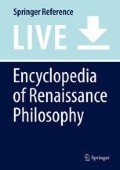Abstract
With only Apuleius and Augustine as partial exceptions, Latin Antiquity did not know Archimedes as a mathematician but only as an ingenious engineer and astronomer, serving his city and killed by fatal distraction when in the end it was taken by ruse. The Latin Middle Ages forgot even much of that, and when Archimedean mathematics was translated in the twelfth and thirteenth centuries, almost no integration with the traditional image of the person took place.
With the exception of Petrarca, who knew the civically useful engineer and the astrologer, fourteenth-century Humanists show no interest in Archimedes. In the fifteenth century, “higher artisans” with Humanist connections or education took interest in Archimedes the technician and started identifying with him. In mid-century, a new translation of most works from the Greek was made by Jacopo Cremonensis, and Regiomontanus and a few other mathematicians began resurrecting the image of the geometer, yet without emulating him.
Giorgio Valla’s posthumous De expetendis et fugiendis rebus from 1501 marks a watershed. Valla drew knowledge of the person as well as his works from Proclus and Pappus, thus integrating the two. Over the century, a number of editions also appeared, the Editio princeps in 1544, and a mathematical work following the footsteps of Archimedes was made by Maurolico, Commandino, and others.
The Northern Renaissance only discovered Archimedes in the 1530s and for long only superficially. The first to express a (purely ideological) high appreciation is Ramus in 1569, and the first to make creative use of his mathematics was Viète in the 1590s.
References
Primary Literature
Baldi, B. 1886. Vite inedite di matematici italiani scritti da Bernardino Baldi. Bullettino di Bibliografia e di Storia delle Scienze matematiche e fisiche, ed. E. Narducci, 19, 335–406, 437–489, 521–640.
Burley, Walter. 1487. Libellus de vita et moribus philosophorum et poetarum. Antwerpen: Drucker der Mensa philosophica.
Cardano, G. 1550. De subtilitate libri XXI. Nürnberg: Ioh. Petreius.
Cardano, G. 1663. Operum tomus quartus. Lyon: Jean Antoine Huguetan & Marc Antoine Ragaud.
Commandino, F. 1558a. Archimedis Opera nonnulla. Venezia: Manuzio.
Commandino, F. 1558b. Commentarii in Opera nonnulla Archimedis. Venezia: Manuzio.
Commandino, F. 1565a. Archimedis De iis quae vehuntur in aqua libri II. Bologna: Benacci.
Commandino, F. 1565b. Liber de centro gravitatis solidorum. Bologna: Benacci.
de Beauvais, Vincent. 1624. Bibliotheca mundi seu speculi maioris. Tomus quartus, Speculum historiale. Douai: Baltazar Bellerus.
Gaurico, Luca. 1503. Tetragonismus idest circuli quadratura per Campanum, Archimedem Syracusanum atque Boetium mathematicae perspicassissimos adinventa. Venezia: Giovanni Battista Sessa.
Leonardo da Vinci. 1883. Literary works, 2 vols. London: Sampson Low, Marston, Searly & Rivington.
Pacioli, Luca. 1494. Summa de Arithmetica Geometria Proportioni et Proportionalita. Venezia: Paganino de Paganini.
Pacioli, Luca. 1509. Divina proportione. Venezia: Paganius Paganinus.
Petrarca, F. 1874. Razzolini, Luigi. (ed., trans.) 1874. Le vite degli uomini illustri di Francesco Petrarca, 2 vols. Bologna: Gaetano Romagnoli, 1874, 1879.
Petrarca, F. 1943. In Rerum memorandarum libri, ed. G. Bilanovich. Firenze: Sansoni.
Ramus, Petrus. 1569. Scholarum mathematicarum libri unus et triginta. Basel: Eusebius Episcopius.
Regiomontani, J. 1972. In Opera collectanea, ed. F. Schmeidler. Osnabrück: Otto Zeller.
Tartaglia, Nicolò, ed. 1543. Opera Archimedis syracusani philosophi ed mathematici ingeniosissimi. Venezia: Venturino Ruffinello.
Tartaglia, Nicolò. 1560. La quarta parte del general trattato de’ numeri et misure. Venezia: Curtio Troiano.
Valla, Giorgio. 1501. De expetendis et fugiendis rebus opus, 2 vols. Venezia: Manuzio.
Vasari, G. 1846. Le vite de' più eccellenti pittori, scultori e architetti, 13 vols. Firenze: Le Monnier, 1846–1857.
Venatorius, T.G. 1544. Archimedis Syracusani philosophi ac geometrae excellentissimi Opera, quae quidem extant omnia. Basel: Hervagius.
Secondary Literature
Clagett, Marshall, 1964. Archimedes in the Middle Ages, vol I. The Arabo-Latin tradition. Madison: University of Wisconsin Press.
Clagett, Marshall. 1976. Archimedes in the Middle Ages, vol II. The translations from the Greek by William of Moerbeke. Philadelphia: The American Philosophical Society.
Clagett, Marshall. 1978. Archimedes in the Middle Ages, vol III. The fate of the Medieval Archimedes 1300–1565. Philadelphia: The American Philosophical Society.
d’Alessandro, Paolo, and Pier Daniele Napolitani. (ed., trans.) 2012. Archimede latino: Iacopo da San Cassiano e il corpus archimedeo alla metà del quattrocento. Paris: Les Belles Lettres.
Høyrup, Jens. 1992. Archimedism, not Platonism: on a malleable ideology of Renaissance mathematicians (1400 to 1600), and on its role in the formation of seventeenth-century philosophies of science. In Archimede. Mito Tradizione Scienza, ed. Corrado Dollo, 81–110. Firenze: Leo S. Olschki.
Høyrup, Jens 2017. Archimedes – Knowledge and Lore from Latin Antiquity to the Outgoing European Renaissance. Ganita Bhāratī 39:1–22.
Laird, W. Roy. 1991. Archimedes among the Humanists. Isis 82: 629–638.
Rose, Paul Lawrence. 1975. The Italian Renaissance of mathematics. In Studies on humanists and mathematicians from Petrarch to Galileo. Genève: Droz.
Unreferenced translations. are due to the author.
Author information
Authors and Affiliations
Corresponding author
Editor information
Editors and Affiliations
Section Editor information
Rights and permissions
Copyright information
© 2019 Springer Nature Switzerland AG
About this entry
Cite this entry
Høyrup, J. (2019). Archimedes: Reception in the Renaissance. In: Sgarbi, M. (eds) Encyclopedia of Renaissance Philosophy. Springer, Cham. https://doi.org/10.1007/978-3-319-02848-4_892-1
Download citation
DOI: https://doi.org/10.1007/978-3-319-02848-4_892-1
Received:
Accepted:
Published:
Publisher Name: Springer, Cham
Print ISBN: 978-3-319-02848-4
Online ISBN: 978-3-319-02848-4
eBook Packages: Springer Reference Religion and PhilosophyReference Module Humanities and Social SciencesReference Module Humanities

